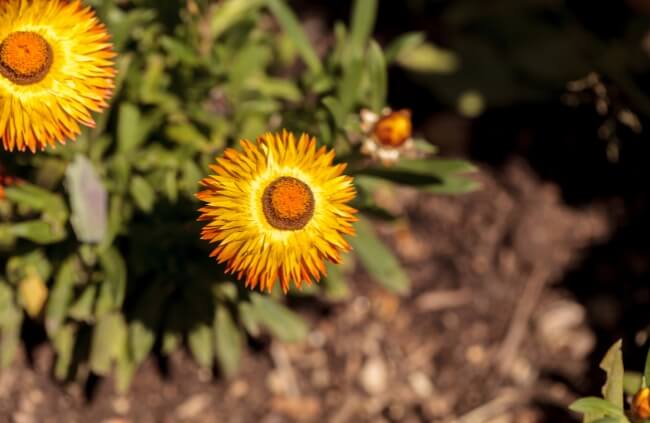Formerly known as Helichrysum, Bracteantha bracteata belongs to the Asteraceae family and are affectionately known as paper daisies, golden everlasting, the everlasting daisy or strawflowers. And each of these names are apt.
More...
Bracteantha | Paper Daisies
Their glowing flowers blaze hotter than the noonday sun in such vivid colours from bright yellows to hot pinks and almost any shade in between. Yet they appear to be soft and fragile like an Aster or Gerbera bloom but upon touching them you’re almost taken aback as they feel just like paper.
Actually, if you didn’t know what they were you would swear that you had been sold an artificial plant. Fortunately, they’re real – yet incredible.
Bracteantha are in a class all their own. They grow well as perennials but most gardeners tend to treat them as annuals or at least replace them every 2-3 years. They have a habit of getting a little leggy and when they’re not flowering they look ordinary at best – a scruffy set of mid-green, elongated leaves that droop like they need watering.
Most cultivars of Bracteantha are grown as groundcovers but they can reach up to 1 m when fully grown and make wonderful companions to less showy foliage plants. They’re even recommended by the CRC for Australian Weed Management as a great alternative to many of the ornamentals such as Arctotis and Gazanias.

Bracteantha bracteata Cultivars and Varieties
- Bracteantha bracteata ‘Sundaze’
- Bracteantha bracteata ‘Bright Bikini’ – A bright orange Bracteantha that looks incredibly artificial with its gloss sheen.
- Bracteantha bracteata ‘Colourburst Pink’
- Bracteantha bracteata ‘Dargan Hill Monarch’ – Yellow and orange blooms with silver-grey foliage.
- Bracteantha bracteata ‘Diamond Head’
- Bracteantha bracteata ‘Cockatoo’
Best Conditions for Growing Strawflowers
Bracteantha are a little fussy when it comes to their growing conditions and environment. They’re not really fussed on humidity so will struggle in tropical areas where moisture levels are high. They much prefer a dry heat during summer and mild winters where average rainfalls are available.
They really shouldn’t need any extra watering after some initial TLC. However, when starting them off in their garden bed, or plant container, Bracteanthas will need some regular watering and some nitrogen-free liquid fertiliser to get them going.
Do Bracteantha make a great cut flower?
They sure do but it’s best to pick them once the buds are half-opened. If you pick them too early they may fail to open properly and if you pick them too late they may not last in your vase all that long.
Published on June 6, 2023 by Nathan Schwartz
Last Updated on September 23, 2024




